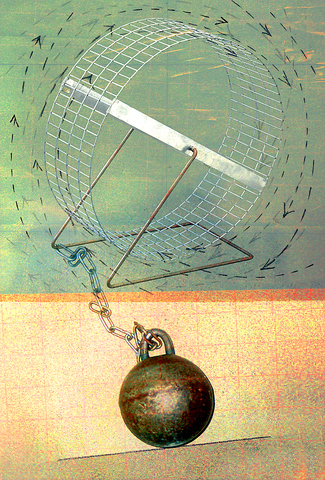Many people have asked me why my knees were hobbled by arthritis long before I turned 60. Being born bowlegged gave them a start. But I made things worse by jogging daily for about 10 years and playing singles tennis for an hour nearly every day for more years than I can remember, until increasing knee pain forced me to cut back to three or four times a week.
Still, in winter, I went ice skating most days, and during the warmer months, I cycled 20km nearly every morning. About the only activity that did not damage my knees was lap swimming, which I did four or five times a week. I loved my activities and planned my life around them, scheduling my workouts around family and professional obligations.
When I couldn't do my daily activities -- typically two or three a day -- for reasons of weather, travel or closings of the facilities, I felt out of sorts, even guilty, and worried about gaining weight. Had I been assessed by a sports medicine specialist at the time, I would have scored high on the scale of exercise addiction.

ILLUSTRATION BY STUART BRADFORD, THE NEW YORK TIMES
To use a less pejorative and more accurate term, I was an obligatory exerciser, overly committed to an exercise routine probably to the detriment of my body if not to my psychological and social well-being.
While most Americans remain sadly sedentary, there is a small group of active people for whom exercise becomes something of an obsession, pursued despite physical injuries, damaged relationships and time stolen from work, family and social activities.
Do you remember Jim Fixx, author of the best-seller The Complete Book of Running, which sparked the fitness revolution? Fixx ignored signs of impending heart trouble and died while running at 52. An estimated 10 percent of runners are obligatory exercisers, according to a 1982 report in The Journal of Sports Psychology.
A classic example was described in the June issue of The Physician and Sportsmedicine by John Draeger and Alayne Yates, psychiatrists at the University of Hawaii, and Douglas Crowell, a sports scientist in Honolulu. They used "obligatory exerciser" to describe someone "who feels obligated or compelled to continue exercising despite the risk of adverse physiologic or psychological" consequences. These may include injuries caused by overtraining and social isolation. "When confronted with a decrease in performance, they will push their bodies harder to succeed," the experts wrote.
Aerobic activity that burns 2,000 to 3,500 calories a week is considered the amount of exercise to attain and maintain optimal health. This would entail 40 to 60 minutes of cardiovascular exercise four to six times a week. Beyond that, there are no added health benefits, but there is an increased risk of exercise-induced injuries.
Excessive exercise can damage tendons, ligaments, bones, cartilage, joints and muscles and not give minor injuries a chance to heal. Instead of building muscle, too much exercise can lead to muscle breakdown. Girls and young women may stop menstruating and start losing bone, as if they were in menopause.
But it is not so much the amount of activity that defines the obligatory exerciser as it is its effects. Some people's bodies can handle more physical stress than others. While there is no clear definition of obligatory exercise, there are telltale signs that exercise is becoming too important to a person, including anxiety, apathy, chronic fatigue, decreased appetite, depression, hostility, mental exhaustion and mood changes.

May 11 to May 18 The original Taichung Railway Station was long thought to have been completely razed. Opening on May 15, 1905, the one-story wooden structure soon outgrew its purpose and was replaced in 1917 by a grandiose, Western-style station. During construction on the third-generation station in 2017, workers discovered the service pit for the original station’s locomotive depot. A year later, a small wooden building on site was determined by historians to be the first stationmaster’s office, built around 1908. With these findings, the Taichung Railway Station Cultural Park now boasts that it has

Wooden houses wedged between concrete, crumbling brick facades with roofs gaping to the sky, and tiled art deco buildings down narrow alleyways: Taichung Central District’s (中區) aging architecture reveals both the allure and reality of the old downtown. From Indigenous settlement to capital under Qing Dynasty rule through to Japanese colonization, Taichung’s Central District holds a long and layered history. The bygone beauty of its streets once earned it the nickname “Little Kyoto.” Since the late eighties, however, the shifting of economic and government centers westward signaled a gradual decline in the area’s evolving fortunes. With the regeneration of the once

The latest Formosa poll released at the end of last month shows confidence in President William Lai (賴清德) plunged 8.1 percent, while satisfaction with the Lai administration fared worse with a drop of 8.5 percent. Those lacking confidence in Lai jumped by 6 percent and dissatisfaction in his administration spiked up 6.7 percent. Confidence in Lai is still strong at 48.6 percent, compared to 43 percent lacking confidence — but this is his worst result overall since he took office. For the first time, dissatisfaction with his administration surpassed satisfaction, 47.3 to 47.1 percent. Though statistically a tie, for most

In February of this year the Taipei Times reported on the visit of Lienchiang County Commissioner Wang Chung-ming (王忠銘) of the Chinese Nationalist Party (KMT) and a delegation to a lantern festival in Fuzhou’s Mawei District in Fujian Province. “Today, Mawei and Matsu jointly marked the lantern festival,” Wang was quoted as saying, adding that both sides “being of one people,” is a cause for joy. Wang was passing around a common claim of officials of the People’s Republic of China (PRC) and the PRC’s allies and supporters in Taiwan — KMT and the Taiwan People’s Party — and elsewhere: Taiwan and